The world of direct mail evolves as technology advances, offering new opportunities for nonprofit organizations to enhance their communication strategies. Automated direct mail revolutionizes how nonprofits approach their outreach strategies, bringing efficiency and surgical precision to traditional methods. This playbook serves as a guide for executives and managers at nonprofits, aiming to demystify automated direct mail and leverage its capacity to boost both fundraising efforts and membership growth.
The playbook highlights the key differences between traditional and automated direct mail and outlines distinct benefits that automation brings to the table. Nonprofits stand to gain significantly by adopting this modern approach, with improvements in targeting, personalization, and overall campaign effectiveness.
- Efficient campaign management through automation
- Enhanced personalization for donor and member engagement
- Improved tracking and analytics for measurable impact
By exploring direct mail automation specific to nonprofits, the playbook aims to equip leaders with actionable strategies to leverage this evolving channel for increased success.
Overview: Direct Mail Automation for Nonprofits
Automated direct mail is revolutionizing the channel for nonprofits. It ends up being not just about automation; it becomes empowering for overworked, stressed out fundraising teams that have to do more with less. Direct mail automation platforms integrate cutting-edge technology to streamline the entire process—management, sending, tracking—so nonprofits can ditch the drudgery and focus on their mission. Old direct mail roadblocks are eliminated: slow turnaround, rigid minimums, and impersonal campaigns.
With marketing automation tools, nonprofit organizations can customize mail content, ensuring each piece speaks directly to the recipient’s interests throughout the donor journey. Automation allows for precise list segmentation and personalization, essential components for fostering meaningful engagement with donors and members. With data-driven insights, nonprofits can make informed decisions about target audiences, crafting compelling campaigns that resonate with potential donors or members.
Automated direct mail solutions can manage multiple touchpoints while ensuring consistent delivery schedules, enabling nonprofits to time their outreach efforts strategically for maximum impact. No longer must they limit their mailing activities to large, widely spaced and mostly generic approaches. Nonprofit organizations use direct mail because it is effective, consistently delivering high response rates. When combined with automation’s sophistication, nonprofits gain from a robust mechanism to enhance donor relationships, boost fundraising efforts, and increase membership growth. Ultimately, automated direct mail serves as a vital tool in a comprehensive nonprofit marketing strategy, delivering measurable results and sustainable growth.
Direct mail has always been delivered to nonprofits. Automation just makes it work harder, smarter and better.
Automated Direct Mail Ideas for Fundraising
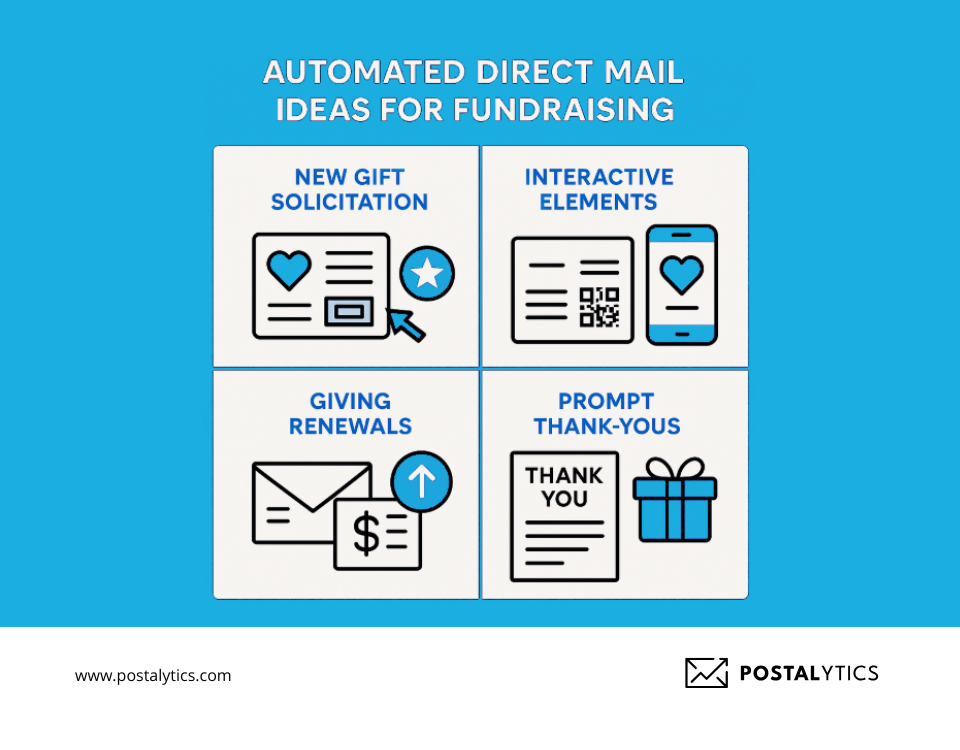
Automated direct mail is transforming fundraising strategies for nonprofits. By streamlining outreach and improving donor engagement, automation allows organizations to create personalized, impactful campaigns. Let’s explore the specific types of campaigns that particularly benefit from this approach.
New Gift Solicitation
Nonprofit organizations can use the power of automated direct mail to improve their new gift solicitation efforts in several innovative ways. Automation makes it easy to integrate direct mail into omnichannel campaigns and manage multiple touchpoints in the donor journey, eliminating time-consuming manual project management. Eye-catching visuals and compelling storytelling allow organizations to send personalized donation appeals that resonate with new donors. Messages can be tailored to match each recipient’s potential interests and preferences, increasing engagement and connection.
Data-driven insights allow nonprofits to segment their prospect list and craft specific appeals for different segments, enhancing the relevance and impact of the campaign. Prospective donors might receive a mail piece that introduces the organization’s mission and invites them to contribute to a new project. Personalized welcome packages can include a call to action that reinforces the organization’s objectives.
Automation technology integrates variable data printing, enabling highly personalized content with names, images, specific donation suggestions, and tailored messaging.
Interactive elements in nonprofit direct mail significantly elevate engagement and attract new donors. Incorporating elements like QR codes allows recipients to engage seamlessly from physical mail to digital platforms. Scannable QR codes direct donors to dedicated landing pages, countdown timers, or video messages, fostering a more dynamic experience. Personalized URLs directed to customized web pages ensure smooth transitions from offline to online, reinforcing the organization’s message and fostering personal relationships.
With automated follow-up mailings, nonprofits continue to supply givers with updates on how new contributions make a difference, encouraging ongoing support. Prompt thank-you letters reinforce donor satisfaction and cement relationships, leading to a higher likelihood of future contributions.
Offering exclusive content or benefits in response to a donation request stimulates donor interest and engagement. Paired with a follow-up thank-you, incentives might include invitations to special events or insider updates, ensuring that donors feel integral to the nonprofit’s mission.
Giving Renewals
Nonprofits can automate the entire contact sequence via CRM software that integrates with the direct mail platform. The CRM system supplies variable information that personalizes the direct mail messages while also controlling when the mailings occur. Once a donor responds by renewing, the CRM system switches off the renewal campaign and invokes the thank-you and donor retention communications.
Renewing the support of existing donors is increasingly important for nonprofit organizations, as the cost of acquiring new donors has risen steadily. Direct mail automation provides immediate benefits to organizations seeking to boost their renewal metrics, particularly by connecting to the data sources such as CRM, Marketing Automation and CDP platforms that store donation histories. By deploying flexible, highly personalized creative templates, savvy nonprofits can setup automated workflows to trigger appeals in sequences that send highly personalized renewal request with giving matrixes designed to drive renewals higher.
Segmenting donor lists plays a crucial role here. By categorizing donors according to past interactions, the organization tailors the messages to resonate more effectively. Targeted campaigns with personalized interactions foster deeper relationships, leveraging the higher open rates that direct mail offers over other channels, such as email.
For repeat givers, supply specific examples of the impact of a donor’s past contributions and encourage further support to enable continuing benefits. Suggest slightly higher giving levels from the preceding donation and explain what a new giving level can accomplish.
Many nonprofit organizations benefit from converting single-gift givers into recurring donors. Offer enhanced recognition or special rewards available only to recurring donors and explain how sustained support helps the organization achieve its goals.
Here’s an example of a simple 2 x 2 giving matrix that can help segment donors.
| Low Engagement | High Engagement | |
| High Capacity | Prospective Major Donors – Needs cultivation to increase involvement. Personalized outreach recommended. | Major Donors & Champions – High-priority donors for major gifts. Focus on relationship-building and personalized appeals. |
| Low Capacity | New or Occasional Donors – Needs stewardship and engagement campaigns to boost involvement. | Loyal Supporters & Advocates – Best for recurring gifts, peer-to-peer fundraising, and grassroots advocacy. |
Once your CRM or other data source has your donors properly segmented, your direct mail automation software can generate highly personalized appeal letters leveraging that data without manual intervention:
[Your Nonprofit’s Name] [Your Address] [Date]
[Donor’s Name] [Donor’s Address]
Dear [Donor’s First Name],
As a valued supporter of [Your Nonprofit’s Cause], your generosity has made a direct impact on [specific achievement or success story]. Thanks to donors like you, we have [describe impact, such as “provided meals for 5,000 families” or “funded life-changing research”].
We’re reaching out today because your support is more crucial than ever. Based on your past generosity, we believe you’d be a wonderful partner in helping us achieve [specific goal]. Your continued support can:
- [Benefit #1, e.g., “Provide clean water to an additional 1,000 families”]
- [Benefit #2, e.g., “Help us expand our outreach programs by 20%”]
- [Benefit #3, e.g., “Fund new scholarships for underprivileged students”]
Would you consider making a gift of [$Suggested Amount Based on Giving Matrix] today? Your contribution at this level would help ensure [specific impact].
💙 Giving is easy! You can make a donation by:
- Online: Visit [Donation Website]
- Mail: Use the enclosed reply envelope
- Phone: Call us at [Phone Number]
Every dollar matters and your commitment means the world to us. Please join us in making a difference today.
With gratitude,
[Your Name] [Your Title] [Your Nonprofit’s Name]
P.S. Monthly giving makes an even bigger impact! Consider joining our recurring donor program to sustain this vital work year-round. Learn more at [Recurring Giving Link].
Donation Thank You Letters, Acknowledgements and Stewardship
Nonprofit organizations understand the importance of expressing gratitude to donors and meeting tax compliance requirements, but traditional manual processes for thank-you and tax letters can be time consuming and inefficient. Automating these tasks eliminates the need for labor intensive workflows, like batching and pre-sorting for postal savings, while still allowing for personalized and timely communication. Modern tools enable nonprofits to instantly generate and send customized letters or receipts, reducing administrative burdens and freeing up staff to focus on higher-value activities, such as donor engagement and mission-driven work. This streamlined approach ensures that acknowledgments are sent promptly—whether individually or in bulk—without sacrificing personalization or compliance, ultimately enhancing donor relationships and organizational efficiency
Tax receipts accompany acknowledgments to ensure donors can preserve vital records for their charitable contributions. By providing clear and prompt receipts, organizations illustrate their commitment to transparency and their appreciation for the donor’s support. Regular issuance of these documents assures donors of the integrity and professionalism of the nonprofit.
Additional items, such as special updates or impact reports, can enhance the stewardship process. These items keep donors informed about the positive effects of their contributions, fostering an ongoing sense of involvement and pride in the organization’s achievements. This comprehensive approach to acknowledgments and stewardship ensures a continuing, fruitful relationship between nonprofits and their donors.
Automated Direct Mail Ideas for Membership Marketing
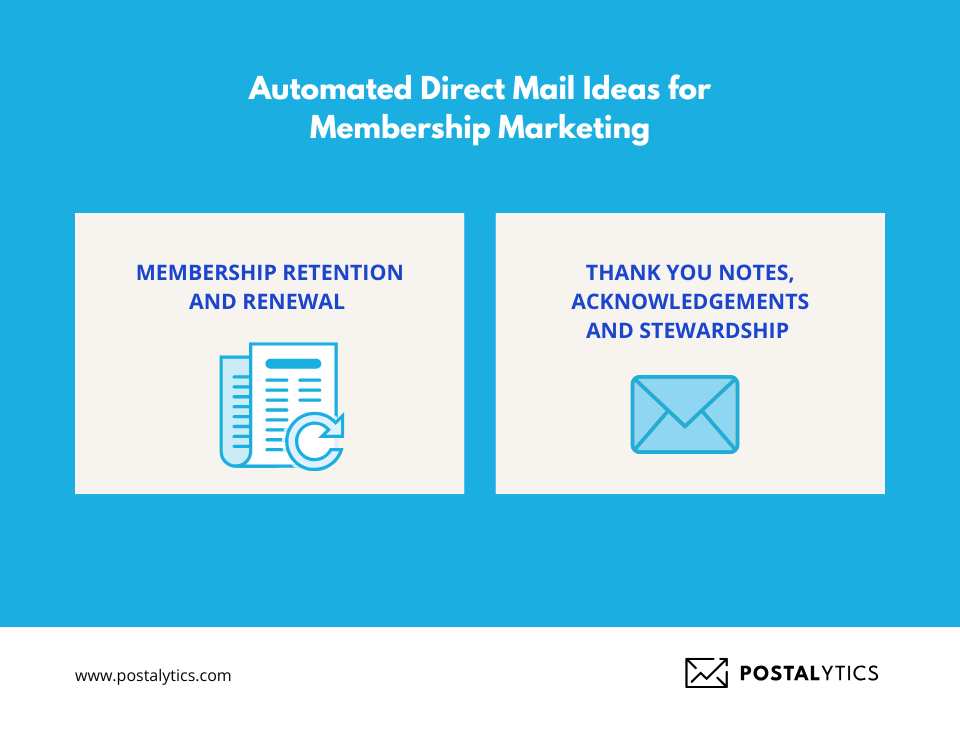
Nonprofits can harness the power of automated direct mail for new member acquisition by utilizing data-driven insights to tailor messages specifically for different segments.
In a traditional direct mail workflow, this segmentation complicates the spreadsheets typically used as data sources for campaigns, with each segment requiring additional spreadsheet columns and increased data management.
Direct mail automation simplifies and streamlines the use of segmented donor data. Segmentation data flows directly out of databases designed to manage complex data into the templated creatives, eliminating the cumbersome step of exporting to a spreadsheet, modifying the spreadsheet, and emailing the spreadsheet to all parties involved in producing the campaign. This makes it easier to appeal to each recipient’s unique interests and motivations. With strategically planned mailings, nonprofits attract new members and engage them meaningfully from the very first contact.
Nonprofit member organizations, such as professional associations, can leverage automated direct mail to attract new members by creating compelling campaigns that highlight the organization’s unique offerings. Tailored messages resonate more with potential members, capturing their interest and encouraging them to join. Effective campaigns make use of targeted mailing lists, ensuring outreach efforts reach individuals who are more likely to engage with the organization.
Automation allows mailings to be optimized by region, for instance, reaching out to prospective members across multiple segments. The direct mail automation platform handles the messaging, variable graphics, and offers according to the interests of each targeted group.
Organizations aiming to grow their membership base should emphasize their unique value propositions in automated direct mail campaigns. By clearly articulating the benefits and opportunities available to new members, organizations can pique interest and prompt action. Careful segmentation of mailing lists allows nonprofits to identify potential members aligned with their mission and values, enhancing the chances of conversion.
To maximize engagement, organizations should employ personalization techniques, such as addressing recipients by name and referencing events that may appeal to them. A strong call to action within the mail piece guides recipients toward the desired outcome. The object of the campaign may include attending an event, signing up for a trial membership, or engaging with online content to learn more.
Incorporating visually appealing design elements and concise, impactful messaging also contributes to successful new member acquisition. By focusing on high-quality content and strategic delivery timing, organizations create a powerful tool for expanding their reach and drawing new supporters into their community.
Most nonprofit membership organizations launch annual membership drives. The constraints of traditional direct mail encourage large mail volumes that lower the per-piece cost and postage for the campaign.
With an automated direct mail platform, the minimum volume requirement no longer exists. Nonprofit membership organizations may decide their needs are better met with membership campaigns that run quarterly, monthly, or even continuously.
Membership Retention and Renewal
Maintaining existing members’ engagement is crucial for sustaining an organization’s growth. Automated direct mail can effectively remind members of upcoming renewals, using personalization to reflect individual participation and impacts. Encouraging timely renewals with tailored incentives or showcasing ongoing project impacts nurtures a sense of belonging and importance, motivating members to continue their association.
Automated direct mail keeps members informed and appreciated, reinforcing their value within the community in a way that electronic messaging cannot. Crafting messages that celebrate milestones, furnish updates on initiatives, and solicit feedback contributes to preserving active members by continually engaging them in the organization’s mission. Delivering these messages through postal mail makes them more likely to be seen and acted upon by the members who might disregard similar communications landing in their email inboxes.
Thank You Notes, Acknowledgements and Stewardship
Direct mail automation truly shines when it empowers nonprofits to move quickly and respond to the moment. Here are some ways to leverage triggered mail and automated direct mail for timely impact:
Expressing Gratitude Instantly:
Automate personalized thank-you letters triggered by online donations, event attendance, or volunteer sign-ups. Move beyond generic email acknowledgments to create a tangible connection that strengthens donor loyalty.
Responding to Urgent Needs:
Disasters: In times of crisis, trigger mailings to specific donor segments with urgent appeals for disaster relief, updates on relief efforts, and invitations to participate.
Funding Cuts: When facing funding reductions, nonprofits can swiftly deploy targeted direct mail campaigns to communicate the impact, solicit emergency donations, and advocate for support.
Capitalizing on Current Events:
Trigger mailings that connect your organization’s mission to relevant news stories, social trends, or cultural moments.
Educate, engage, and inspire action by demonstrating your organization’s relevance in the current landscape.
Advocacy and Awareness:
Use triggered mail to send personalized letters to legislators or community leaders based on their voting records or public statements.
Automate the delivery of informational packets or action alerts to mobilize supporters around critical issues.
By integrating Postalytics’ automated direct mail with a strategic approach to triggered campaigns, nonprofits can amplify their impact, build stronger relationships, and create lasting change.
Automated Direct Mail Execution and Best Practices
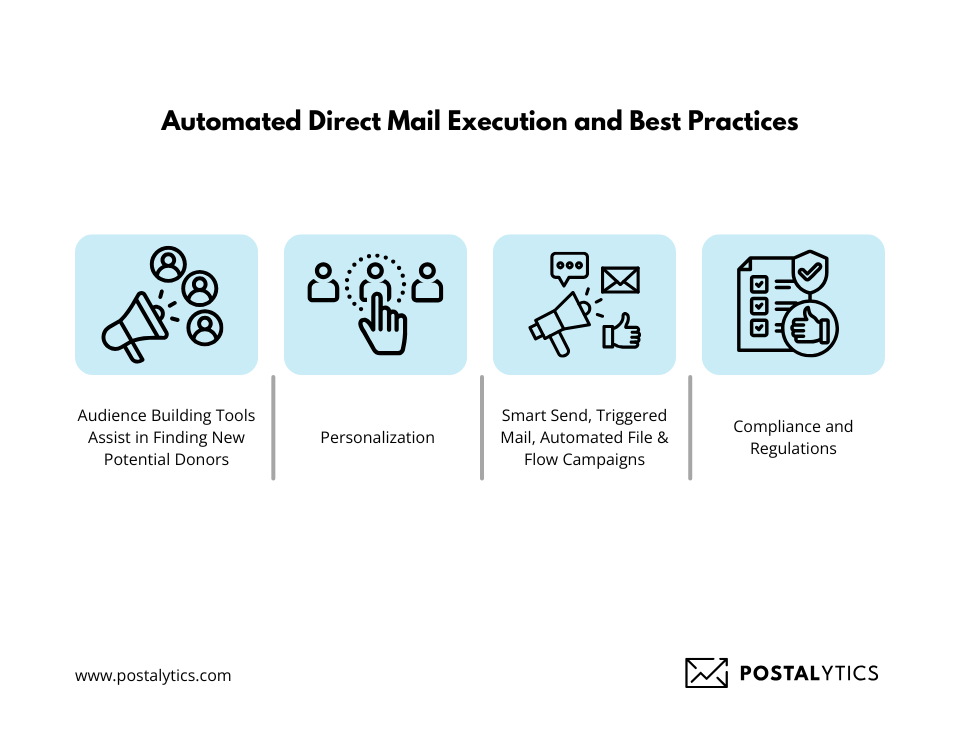
When discussing mailing options and automation, one must consider a variety of strategies. Automated platforms, like Postalytics, enable organizations to execute powerful direct mail campaigns rapidly. Selecting the right options involves assessing audience size, geographic spread, organization objectives, and budget constraints.
Audience Building Tools Assist in Finding New Potential Donors
Direct mail automation platforms empower nonprofits to build and purchase highly targeted audiences by incorporating integrated audience building tools that enable fast & easy geographic, demographic, and psychographic selects. These tools enable organizations to segment potential donors based on location, socioeconomic characteristics, and psychological traits. Additionally, nonprofits can leverage data on donors’ propensity to give, which reflects their likelihood of donating based on past giving behavior and alignment with philanthropic causes. By combining these insights with up-to-date consumer, donor, and new mover databases, nonprofits can refine their outreach strategies with precision.
Automation further removes the barriers of traditional mailing processes, allowing nonprofits to focus on A/B testing various audience segments to continually optimize their ideal donor profiles and maximize campaign effectiveness.
List Management and Segmentation
Effective list management and segmentation remain crucial to successful direct mail campaigns for nonprofits. By analyzing donor and member databases, organizations can segment audiences based on shared characteristics and behaviors, such as donation history, membership duration, gender, or geographic location. Regularly update and cleanse lists to eliminate duplicate entries or outdated addresses, maintaining accuracy and relevance.
Postalytics automatically corrects and updates mailing addresses, assuring nonprofit organizations do not waste money to produce undeliverable mail. We’ll tell mailers about any addresses we could not correct so they can revise or drop them before the next mailing.
With automated direct mail, nonprofits can construct mailings of any size, drawing from many segments. It is no longer necessary to physically separate segments, allowing organizations greater flexibility in who they want to contact, and when.
Personalization
Personalization significantly boosts engagement rates and fosters stronger connections with recipients. Tailor messages, acknowledging each recipient’s specific contributions, membership status, or former interactions with the organization. Leverage customizable templates and variable data printing to address individuals by name and include relevant messaging aligned with their interests.
By connecting a direct mail platform to the organization’s CRM system, fundraisers can leverage any and all of the donor data and giving history easily in their creative strategies, all without exporting and managing spreadsheets.. Templates featuring conditional logic and variable data simplify maintenance and allow for highly personalized and targeted mail that produces results.
Smart Send, Triggered Mail, Automated File & Flow Campaigns
Smart Send, triggered mail, automated file and Flows campaigns offer diverse strategies for nonprofits. These three methods of generating direct mail have unique features that make them the appropriate solution for any situation.
Smart Send most closely matches a traditional mail campaign. The nonprofit chooses the mailing list, the mailing date, and schedules the job. All the Postalytics features such as QR codes, personal URLs, tracking, and variable data personalization are available. Use Smart Send when the material is date-sensitive, such as when promoting an event or coinciding with a multi-channel campaign.
Triggered mail dispatches automatically upon specific events or actions, such as first-time donations, membership sign-ups, or upcoming renewal dates, cementing positive engagement. This is a powerful way to leverage direct mail that delivers the right message to the right recipients at the exact right time.
Automated file campaigns regularly send mail to a pre-defined list using an automated system, ensuring consistent communication cycles. When new names are added to the list, the automated file campaign issues the designated mail pieces.
Campaign Flows is a powerful workflow automation tool from Postalytics that simplifies the execution of multi-touch direct mail campaigns.
Designed to integrate seamlessly with triggered drip or automated file campaigns, it allows organizations to create structured sequences that guide recipients through targeted messaging based on timing, events, or specific conditions. With features like conditional branching and automated tracking of donations, Campaign Flows eliminates the complexity of managing multi-step campaigns. Fundraisers can use this tool for creative A/B testing, suppression list management, and optimizing outreach strategies to ensure precise, impactful communication. By leveraging Campaign Flows, nonprofits can save time and focus on delivering results-driven campaigns with ease.
Compliance and Regulations
Compliance and regulations demand strict adherence to rules governing direct mail practices. Organizations must familiarize themselves with state and federal guidelines, such as the guidelines outlined by the United States Postal Service, to avoid penalties or unplanned expenses. Ensure data protection and privacy by implementing secure data handling practices and acquiring necessary consent for electronic communication included as part of multi-channel campaigns. Regular auditing helps maintain compliance and fosters trust with supporters.
Nonprofits must be particularly vigilant in complying with evolving state-specific privacy laws such as Daniel’s Law in New Jersey, which protects the personal information of certain individuals, and California SB 1096, which expands direct mail privacy requirements. These regulations emphasize the need for organizations to carefully manage personal data, restrict access to sensitive information, and provide recipients with clear opt-out mechanisms. Postalytics helps nonprofits navigate these challenges by offering automated suppression lists, ensuring that protected individuals are excluded from mailings, and built-in opt-out links, making it easy for recipients to control their communication preferences. By leveraging these tools, nonprofits can streamline compliance, avoid legal risks, and maintain trust with their donor base while executing effective direct mail campaigns.
New Direct Mail Automation Technology Destroys Age-Old Constraints
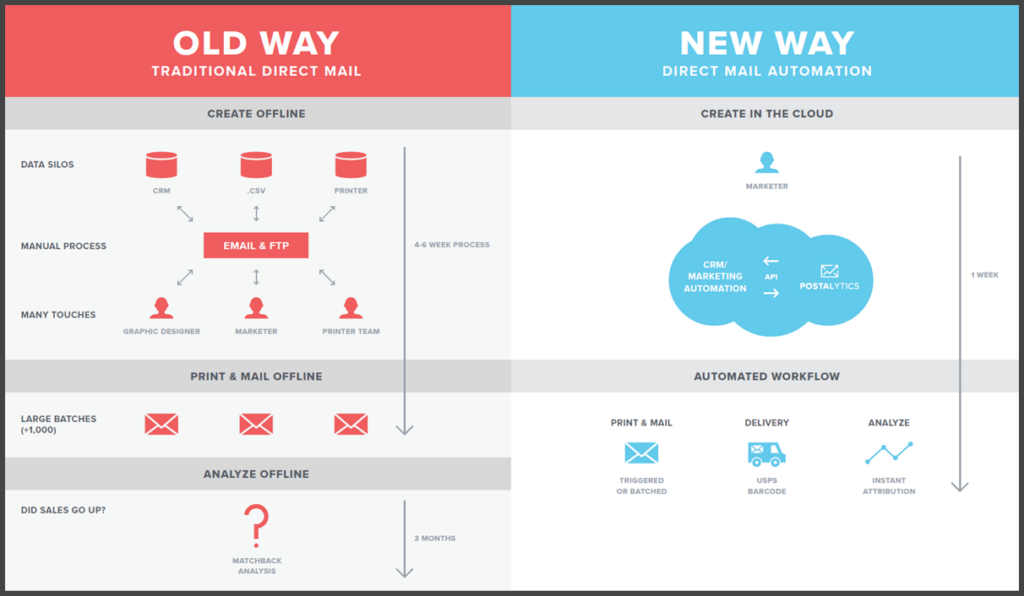
In traditional direct mail campaigns, organizations often face long lead times, with many steps involving multiple entities before a mail piece reaches the recipient. Automated direct mail streamlines this process. The technology reduces time between campaign creation and the mail’s arrival in recipients’ hands. Handling everything in-house minimizes the need to coordinate with various vendors, eliminating the usual complexities in a traditional setup.
Organizations formerly grappled with achieving per-piece affordability, necessitating large order quantities and minimum send volumes to justify costs. Automated direct mail changes the game, allowing for cost-effective campaigns even with smaller batches, without compromising on quality. This flexibility supports more frequent and targeted communication.
Tracking hasn’t been the hallmark of conventional direct mail. With automated direct mail, marketers can integrate tracking through the United States Postal Service and add delivery information to CRM systems. They can offer well-timed insights and data-driven decisions for campaign adjustments, multi-channel messaging, and follow-ups. This feature also enhances transparency and accountability, ensuring each mail piece reaches its intended target or alerting mailers should an unexpected delay occur.
Digital printing allows automated direct mail to excel in personalization, dynamic content, and segmentation. Targeted messages tailored to individual recipients strategically enhance engagement and response rates. Nonprofits can leverage these capabilities, delivering content that resonates deeply with their audience’s interests and needs, positioning their message advantageously in the recipient’s stack of mail.
Smart Send Batch Mail vs Triggered Mail
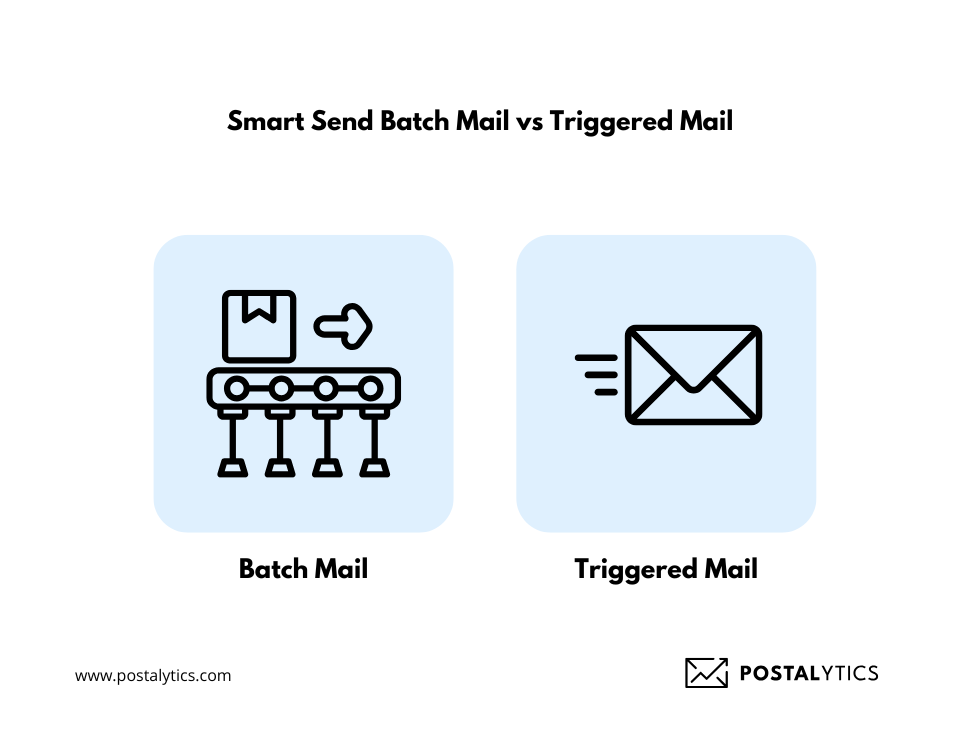
Batch mail and triggered mail represent two distinct strategies within automated direct mail, each offering unique advantages for nonprofits aiming to enhance their communication efforts. Understanding when to deploy each method can make a significant difference in campaign outcomes.
Automated Batch Mail or Smart Send
Batch mail involves sending a quantity of direct mail pieces at once. Nonprofits typically use this approach for broad outreach efforts, such as annual appeals or newsletters. This method benefits organizations by allowing them to reach a large audience efficiently, often timed with specific events on the organizational calendar.
Nonprofit organizations use the batch method when mailing to new lists of individuals. Whether purchased or compiled in-house, these lists usually contain only basic information about the recipients who have no activity history with the nonprofit.
A nonprofit may send a batch mail campaign at the beginning of the holiday season, for instance, taking advantage of the increased giving spirit. Since this method does not rely on specific triggers from recipients, it’s best suited for situations requiring unified messaging to a wide group.
With automated direct mail, variable messages and images are still recommended to segment the batch mailing and deliver relevant communications to each recipient according to known details, like geographic location or age group. Mailers can make use of this targeting functionality without breaking the batch mailing into smaller groups and adversely affecting their presort postage discounts.
Triggered Mail
In contrast to batch mailings, triggered mail is based on specific actions or dates, delivering personalized and opportune messages to recipients. This approach works well for nonprofits seeking to enhance engagement, responding promptly to individual interactions or lifecycle stages.
For example, after an individual donates online, a triggered mail campaign automatically sends a personalized thank-you note. Such mailings thank donors, acknowledge membership renewals, or mark anniversaries of first engagement. This method’s strength lies in its ability to send relevant communication that reflects the donor’s or member’s recent actions, increasing engagement and reinforcing loyalty. Mail recipients feel the nonprofit views them as individuals, not just generic donors or members.
When choosing between batch and triggered mail, nonprofits should consider their goals, the nature of their audience, the amount of available personal data, and the message’s relevancy. Both methods, when used strategically, can significantly boost direct mail marketing effectiveness and enhance relationship-building efforts with supporters.
Budgeting and ROI
Budgeting becomes considerably more straightforward with automated direct mail solutions. Organizations gain from the simplicity of paying a single entity, such as Postalytics, which offers fixed-rate pricing structures. This method contrasts starkly with traditional direct mail, where generating an estimate involves navigating vendors, each with multiple quotes to provide a piece of the full direct mail solution.. This process can consume days, making the automated approach attractive for time and resource management.
For nonprofit fundraisers, managing budgets effectively is crucial, and Postalytics’ Direct Mail Credits offer a solution to the unpredictability of traditional direct mail costs. Unlike traditional direct mail, where expenses can fluctuate due to changes in paper costs, postage rates, and printing fees, Direct Mail Credits provide budget certainty. By purchasing credits upfront, nonprofits can eliminate the variability in pricing, making budget allocation, reconciliation, and future forecasting more straightforward and reliable, regardless of campaign volume. This system allows for precise budget control, helping nonprofits avoid overspending and maintain consistent cash flow throughout the year.
Automated direct mail stands out with its comprehensive tracking capabilities, which makes it easier to monitor campaign ROI. Marketers can effortlessly monitor response rates and observe individual actions throughout the engagement cycle. This ability to track and measure allows organizations to understand their return on investment, offering insights that help refine strategies and optimize outcomes effectively. By leveraging these metrics, organizations can evaluate the success of their campaigns and align their efforts with organizational goals.
Measuring and Improving Campaigns
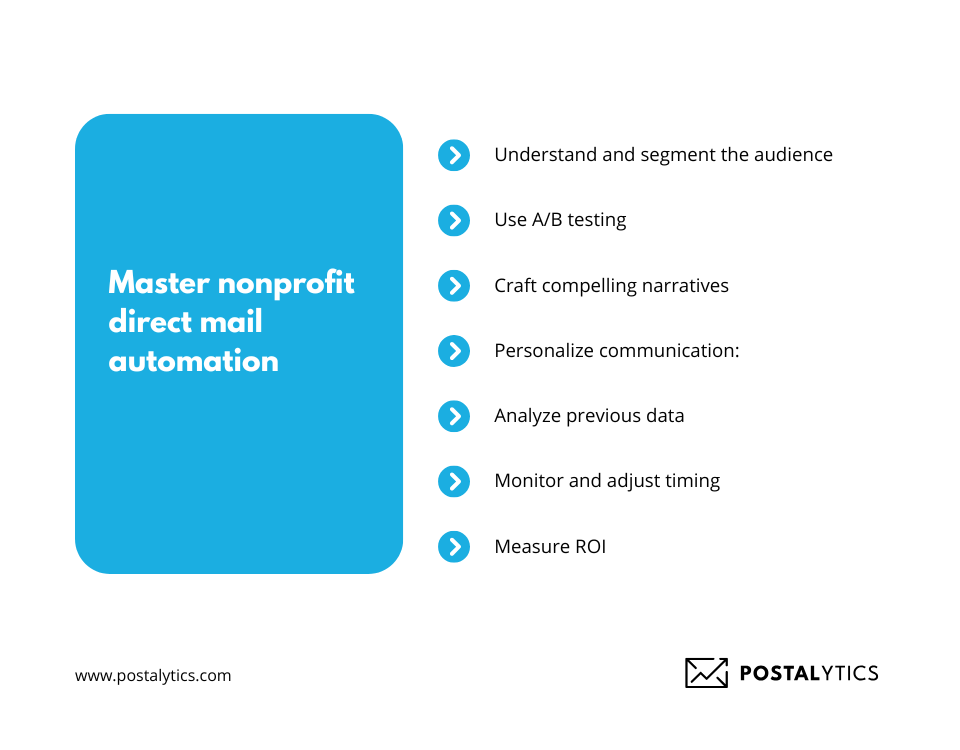
Nonprofit organizations measure the effectiveness of automated direct mail campaigns through various methods. By harnessing comprehensive analytics tools, they can track response rates, donations received, and overall engagement levels. Key performance indicators (KPIs) such as conversion rates, membership growth, cost per response, and donor retention cost, offer valuable insights into campaign performance. Technology like Postalytics enables nonprofits to create campaigns efficiently, while platforms like Fundraising Report Card supply deep analysis for fine-tuning fundraising efforts.
To enhance automated direct mail campaigns, experts suggest a structured approach, changing one variable at a time. Here is a list of measurement and improvement actions:
- Understand and segment the audience: Knowing the target audience allows tailoring of messages that resonate, leading to higher engagement rates. Look for new ways to segment the mailing list-the automated direct mail platform can handle nearly unlimited variety.
- Use A/B testing: Comparing elements within campaigns helps identify successful communication strategies. Try different messages, graphics, and incentives to see which ones perform the best for an audience segment.
- Craft compelling narratives: Telling a powerful story with a clear call to action increases responsiveness. Use the power of personal URLs or QR codes to expand the storytelling to media besides print by linking to online videos.
- Personalize communication: Addressing recipients by name and referencing their specific interests builds connection and trust. Augment mailing list data with added data points that help to personalize or segment the mailings.
- Analyze previous data: Digging into past campaign data to understand patterns will guide future decisions.
- Monitor and adjust timing: Experimenting with send times and frequencies can optimize mail impacts. Find out how many “touches” it takes to get a response.
- Measure ROI: Regularly tracking the return on investment ensures resource allocation aligns with organizational goals. Look for ways to eliminate waste and maximize positive outcomes.
Continuous improvement becomes achievable when nonprofits embrace a proactive, data-driven approach to their automated direct mail campaigns.
Case Studies
Automated direct mail is a perfect fit to help nonprofits pursue their goals. Platforms like Postalytics help these organizations reap the benefits of direct mail while keeping expenses low. Automation eliminates most of the steps that make it difficult to establish and support an effective direct mail strategy using traditional methods.
Here are some examples of cases where nonprofits abandoned traditional direct mail efforts in favor of an automated approach and realized positive results.
The High Museum of Art

The High Museum of Art is the largest art museum in the southeastern United States. They attract over 200,000 visitors annually and maintain a membership of over 30,000 households. The museum uses various methods to communicate with members, with direct mail playing a predominant role. However, manually preparing the postal communications proved time-consuming and cumbersome.
Switching to an automated direct mail solution allowed the museum to streamline communications and personalize member engagement.
Homestart

Homestart helps residents in the Greater Boston area who are experiencing homelessness or housing instability. A small, streamlined admin and development team and a broad network of advocates and case managers offer aid and guidance to residents living at or below the poverty line. Their clients include single parents and their children, victims of domestic violence, veterans, and persons with disabilities.
This nonprofit organization relies on contributions from corporations, foundations, and individuals to pay for the services they provide. Some government grants require matching private contributions, so continuous efforts to attract donors are a vital effort.
Homestart needed to bolster the performance of their electronic messaging efforts and get the attention of their target audience. Adding nonprofit direct mail was an obvious choice.
The Connecticut Project

The Connecticut Project (TCP) is a social change organization focused on improving the lives of low-income residents in Connecticut. With a small staff, they bring communities and resources together, developing solutions, and advocating for government policies that help low-income and asset-limited Connecticut residents.
Direct mail is uniquely positioned to help TCP communicate aspects of its objectives. It is a perfect medium for reaching a subsection of TCP’s low-income target audience. However, executing such direct mail activities without help from an automated direct mail platform would have been a daunting process. The organization turned to The Nonprofit Tech Shop and Postalytics to develop an ideal solution.

